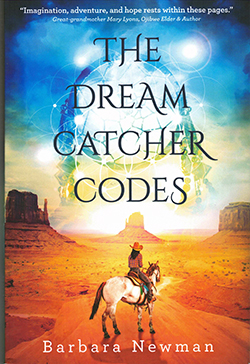The Dream Catcher Codes by Barbara Newman; Brattleboro, Vermont: Green Writers Press; © 2021; ISBN 9781733-653473; 280 pages plus Environmental Resources; $15.95

 SAN DIEGO –This Young Adult novel is a mystical adventure in which four pre-teenage American girls representing the four cardinal directions are brought together to save the world from environmental disaster. The leader, Maia, representing the North, is a Lakota from South Dakota; the others are a Black-Jewish girl from New York (Sara, East); a Chicana from New Mexico, (Ava, South) and a Chinese girl who had been adopted by a Caucasian family in California (Yue, West).
SAN DIEGO –This Young Adult novel is a mystical adventure in which four pre-teenage American girls representing the four cardinal directions are brought together to save the world from environmental disaster. The leader, Maia, representing the North, is a Lakota from South Dakota; the others are a Black-Jewish girl from New York (Sara, East); a Chicana from New Mexico, (Ava, South) and a Chinese girl who had been adopted by a Caucasian family in California (Yue, West).
Each girl is magically invested with the ability to harness one of the basic elements. Maia can root herself in the Earth, resisting evil winds. Sara can expel a good wind from within her own expanding lungs. Ava’s specialty is fire; Yue’s is water. They are carried here and there by four flying horses provided to them by Maia’s mother, Sophia, who is able to monitor their adventures from afar, and, if necessary, come quickly to their aid. Light shining through intricate Native American dream catchers project valuable clues onto walls.
The girls are pitted against magical enemies including malevolent dark clouds that seek to prevent them from finding a magic piece of crystal that was stolen from Sophia by a large raven. The raven also is a dangerous enemy for the girls. The youngsters must beware optical illusions created by supernatural tricksters who would do them harm. If they can somehow find the missing crystal piece, shorn from a horseshoe-shaped crystal, they can reverse some, but not all, the environmental damage being done to the world. For all the damage to be reversed, profligate humanity must change its ways.
The fact that the girls are of four different ethnicities symbolizes one of the messages in the book, that we must all work together; in unity we will find the strength to turn back environmental damage because if left unmolested, the earth can begin to heal itself.
The difference in ethnicities also provides author Barbara Newman with a springboard for interethnic social commentary. For example, Maia tells Sara that her people and other Native Americans are “fighting to keep our sacred lands, struggling to keep our customs alive. Some are struggling just to have enough to eat, and decent health care. The indigenous people of this country are speaking out but so far, it hasn’t made much change. I’m so angry.”
Sara tells Maia, “My mother’s ancestors were born in Eastern Europe—in a tiny village in Poland. They were poor and lived on potatoes and beets and love. They tried to escape the Holocaust. Some of them fled and survived. Others died in the camps.”
Maia concludes from this conversation that both have cultures that were diminished by outside forces. This forges a bond between the two girls. At another point, Maia walks with her eyes closed and a symbol or a letter that looked to Maia like a house transformed itself into the number 18. Sara explains that 18 is the equivalent of the Hebrew word “Chai” for life, which when written looks something like the house Maia described.
The YA novel emphasizes the beauty, power, and healing properties of Nature, teaching the girls (and by extension, the readers) to take the time to study and appreciate their surroundings: the earth below them, the plants; the rocks; the trees; the waters, the skies. All are interrelated parts of the same Mother Earth, as indeed are the girls themselves.
The quest to find the piece of crystal takes the four girls and their flying horses all over the United States, where they learn lessons about life. In this reviewer’s opinion, this section is a bit too cluttered, with facts not easily relatable to the ultimate quest.
One seemingly incongruous portion of this book, given the emphasis on living in full concert with nature, is the fact that the girls, who during their journey subsist on a diet of magical apricots, crave other foods. One girl can hardly wait to sink her teeth into a cheeseburger, apparently unmindful that a cow had to be slaughtered to provide such a meal. An author’s oversight? Or perhaps an indication that although the girls are environmental champions, their education is at yet incomplete?
*
Donald H. Harrison is editor of San Diego Jewish World. He may be contacted via donald.harrison@sdjewishworld.com